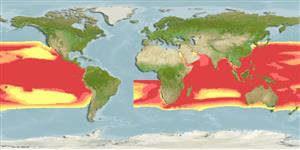>
Beloniformes (Needle fishes) >
Hemiramphidae (Halfbeaks)
Etymology: Euleptorhamphus: Greek, eu = good + Greek, leptos = thin + greek, rhamphos = bill, peak (Ref. 45335).
Environment: milieu / climate zone / depth range / distribution range
Ökologie
seewasser; ozeanodrom (Ref. 51243); tiefenbereich 0 - 1 m (Ref. 58302). Subtropical
Indo-Pacific: Red Sea and East Africa to Hawaii (Ref. 583) and Tonga, north to southern Japan, south to Australia, New Zealand and Kermadec Islands (Ref. 8879). Eastern Pacific: southern California, USA to Ecuador, including the Galapagos Islands (Ref. 2850).
Length at first maturity / Size / Gewicht / Alter
Maturity: Lm ?, range 25 - ? cm
Max length : 53.0 cm TL Männchen/unbestimmt; (Ref. 55763); common length : 30.0 cm SL Männchen/unbestimmt; (Ref. 9306)
Rückenflossenstacheln (insgesamt): 0; Rückenflossenweichstrahlen (insgesamt): 21-25; Afterflossenstacheln 0; Afterflossenweichstrahlen: 20 - 25; Wirbelzahl: 70 - 75. Body very elongate; lower jaw very prolonged; upper jaw short, triangular, and scaly; teeth present on vomer and tongue; dorsal fin with 22 to 25 rays; anal fin with 22 to 24 rays; pectoral fins long, with 8 or 9 rays; back iridescent blue green; belly silvery (Ref. 55763). Fins unpigmented (Ref. 4164).
Usually oceanic but enters large open bays (Ref. 2850). Found around islands (Ref. 9306). Capable of jumping out of the water and gliding above the surface (Ref. 9306).
Life cycle and mating behavior
Geschlechtsreife | Fortpflanzung | Ablaichen | Eier | Fecundity | Larven
Collette, B.B. and J. Su, 1986. The halfbeaks (Pisces, Beloniformes, Hemiramphidae) of the Far East. Proc. Acad. Nat. Sci. Philadelphia 138(1):250-301. (Ref. 10943)
IUCN Rote Liste Status (Ref. 130435)
Bedrohung für Menschen
Harmless
Nutzung durch Menschen
Fischereien: weniger kommerziell
Mehr Information
ReferenzenAquakulturAquakultur ProfilZuchtlinienGenetikElectrophoresesVererbbarkeitKrankheitenVerarbeitungNutrientsMass conversion
PartnerBilderStamps, Coins Misc.LauteCiguateraGeschwindigkeitSchwimmstilKiemenoberflächeOtolithsGehirngrößeSehfähigkeit
Tools
Zusatzinformationen
Download XML
Internet Quellen
Estimates based on models
Preferred temperature (Ref.
123201): 20.2 - 29.2, mean 26.9 °C (based on 43417 cells).
Phylogenetic diversity index (Ref.
82804): PD
50 = 0.7500 [Uniqueness, from 0.5 = low to 2.0 = high].
Bayesian length-weight: a=0.00102 (0.00046 - 0.00225), b=3.06 (2.88 - 3.24), in cm total length, based on all LWR estimates for this body shape (Ref.
93245).
Trophic level (Ref.
69278): 3.4 ±0.45 se; based on food items.
Widerstandsfähigkeit (Ref.
120179): hoch, Verdopplung der Population dauert weniger als 15 Monate. (Preliminary K or Fecundity.).
Fishing Vulnerability (Ref.
59153): Moderate vulnerability (41 of 100).
Nutrients (Ref.
124155): Calcium = 167 [64, 396] mg/100g; Iron = 1.55 [0.67, 3.54] mg/100g; Protein = 18.2 [15.7, 20.6] %; Omega3 = 0.224 [0.091, 0.652] g/100g; Selenium = 10.7 [4.1, 29.3] μg/100g; VitaminA = 21.4 [5.4, 94.5] μg/100g; Zinc = 0.862 [0.517, 1.441] mg/100g (wet weight);
